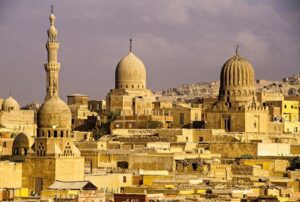The City of The Dead
Classified geographically, with the most important mausoleum in each site:
The southern cemetery: El Imam El Shafy and Mohamed Ali
The North cemetery,: Ashraf Bersebay and Qaitbay
Others: such as the cemetery at the foot of The Citadel and facing El Ftouh and El Nasser.
Tourists tend to feel uneasy about viewing the cemetery’s splendid funerary architecture with squatters living all around or in the tombs but please don’t, these are people who at first were forced to live there because of poverty but now chose to live there and are very friendly.
For many Cairo inhabitants The City of the Dead is a mysterious area. They are aware of its existence but few understand this group of vast cemeteries that stretch out along the base of the Muqattam Hills.
From the Highway, The City of the Dead appears to be organized, a match for the beige, sandy landscape of the distant Citadel. Inside, however these cemeteries bare witness to the centuries of Cairo’s history.
Since the seventh century AD, Cairo rulers chose the area for their tombs outside the crowded city in a deserted location. This area was used as a burial ground for The Arab Conquests,Fatimids, Abbasids, Ayyubids, Mamlukes, Ottomans, and many more.
Among these cemeteries lives a community of Egypt’s urban poor, forming an illegal but tolerated, separate society. More than 1 million Egyptians live in these cemeteries, and have formed their own enterprises.
The cemeteries built in The City of the Dead are much different than the Western idea of cemeteries. This is because traditionally, Egyptians bury their dead underground in room-like burial sites with the corpses walled in, enabling other families without homes to occupy the space. By Cairo standards these are poor and looked down upon neighbourhoods. They have shops, schools and electricity, maybe even piped water and sewers.
The historic belief in Egypt is that the cemeteries are an active part of the community and not exclusively for the dead. Egyptians have not so much thought of cemeteries as a place of the dead, but rather a place where life begins.
In modern times, because of Egypt’s housing crisis, a lack of satisfactory and affordable housing for a rapidly growing population, many poor Egyptians have made these rooms their permanent homes.
They adapted the rooms to meet their needs. They have used the grave markers as desks, and shelves. They have hung strings between gravestones for their laundry to dry out.They have brought in the electricity by wires over the roofs coming from the nearby mosque to be able to be able to live properly.
The City of the Dead seems to its inhabitant’s ideal because it is already built, affordable, and partially equipped. However there are many disadvantages of living there. They are joined by even a greater number of cockroaches, mosquitoes, flies, and vermin of all sorts.The rooms are also filled with the overwhelming smell of the garbage piled outside their doors and sewage leaking out of the un-drained tanks but the people who live there work constantly to have a better way of life.
Today, the population of The City of the Dead is growing rapidly because of rural migration and its complicated housing crisis that is getting worse.
You’ll be marginally less conspicuous on Fridays, when many Cairo residents visit their family plots.
What to see:
Two vast cemeteries that stretch away from The Citadel to merge with newer shanty towns below The Muqattam, The Southern Cemetery and the Northern Cemetery, by contrast, is an unforgettably eerie sight, with dozens of mausoleums rising from a sea of dwellings along the road from Cairo Airport.
-The Southern cemetery:
Mohammed Ali’s family Tombs:
This is quite an important monument though it is rarely visited or mentioned in guide books, probably due to its location and the relative difficulty in accessing it. Nevertheless, it is worth the effort to visit this monument for those who are interested in historic Islamic era monuments and their architecture.
Mohammed Ali, who ruled from 1805-1848, was to known to be very attentive to his family and in particular the education of his children.
Called“Hosh al-Pasha”, meaning the courtyard of The Pasha (a Persian term meaning king), which was given to the Royal family graveyards and more specifically, the (many) descendants of Mohammed Ali’s family.
The Tomb Complex was built in 1854 and in it is buried Mohammed Ali’s wives, children, the close and devoted servants, distinguished statesmen and counsellors.
The six-domed complex, though in somewhat deteriorated shape, still shows much of its original luxurious and rich state. From each corner of the courtyard, one can get a different but fascinating view of the ribbed domes overlapping the courtyard. The facades are all carefully decorated with gypsum window openings that all reflect marvellous shades of light through the coloured glass in the interior chambers, creating rainbows of diffused and subtle lighting.
The interiors are so heavily decorated with inscriptions, precious marbles and amazingly detailed colorful paintings on the ceilings and walls that it takes a moment to absorb all the surrounding work. One must simply stand and gaze for a few minutes to take it all in.
The cenotaphs are exuberantly carved with flowers, garlands, and fronds and are gilded and painted in bright colours. A stela at the head topped by a distinctive coiffure or head-covering indicates the rank and sex of the deceased. Men are identified by turbans or fezzes, women by coronets. The tombs of women are further classified by braids in relief denoting a royal mother; painted braids for a royal wife; and a coil of loosely caught hair, often sprinkled with golden tears, indicating a virgin princess.These turbans, fezzes, tresses, and coronets give to the tombs a funeral reality that is quite emotional and sad. In an outer room, lie the 470 Mamluks or retainers of Mohammed Ali, who is buried in his mosque at The Citadel.
The Mausoleum of Imam al-Shafi’i:
The Imam al-Shafi’i was the founder of one of the four rites of Sunni Islam, and is considered to be one of the great Muslim saints, he came to Egypt in the 9th century. It is also the largest detached mausoleum in Egypt.
-The Northern cemetery:
Mosque and Mausoleum of the ruler Qaitbey:
Sultan Qaitbey was as ruthless as any Mamluk sultan, but he was also something of an aesthete. His mosque, completed in 1474 as part of a much larger funerary complex, is widely agreed to mark the pinnacle of Islamic architecture in Cairo.
The interior is one of the most pleasant places to sit and relax, but the true glory is the exterior of the dome, carved with the finest, most intricate floral designs anywhere in the Islamic world.
Complex of the ruler Farag Ibn Barquq:
This complex (tomb and khanqah) is quite unique in being perfectly symmetrical with twin minarets and domes.
It was completed in 1411 because Barquq had wished to be buried near some particular illustrious Sufi sheikhs. The khanqah, a sort of monastery for a Sufi order, is a fortress like building with high, sheer facades.
The largest stone domes in Cairo with bright painted ceiling. Inside the ceilings are painted in mesmerizing red-and-black geometric patterns.
Complex of the ruler Ashraf Barsbey:
Enclosed by a stone wall midway between Barquq’s tomb and the Mosque of Qaitbey, is the funerary complex of Barsbey, who ruled from 1422 to.
Most of the compound has been lost over the centuries, but the dome of his mausoleum is carved with a beautiful star pattern, and there is some fine marble flooring and an ivory-inlay minbar (pulpit).
Friday market:
Cairo version of Garage Sale, held every Friday morning and attracts many people of different backgrounds, most of them poor people who are looking for cheap options, but few others go there for collecting antiques or for the experience.
A Family House:
Like Sobhi said: (a frame maker who lives in a tomb room in the cemetery with his wife and 3 educated children). we have been forced to make the cemeteries our permanent home because of the country’s chronic housing crisis shortage. We came to live in these cemeteries because they are inexpensive and practical for a starting point. However, soon we realized that it’s not a temporary house and that we want to continue here because these people are kind and all of us here care for each other.
So that you have a chance to talk to them about anything, the guide will translate everything; then by yourself you will recognize their mentality, customs, and lifestyle.
After each visit to this house, we asked our guests about their opinions, they surprised us by their admiration of it, and how much they liked and appreciated it, and that it has the same importance as visiting the momuments.
Blowing glass workshops:
Turn recycled glass into useful and artistic ornaments. All made by hand, in different colours and shapes.

